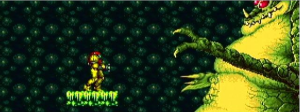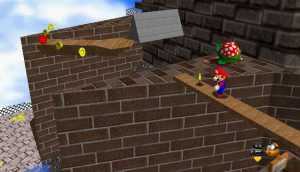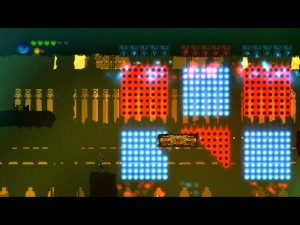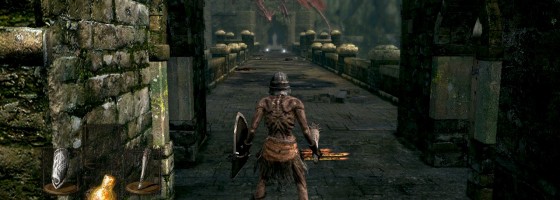Today’s post should be interesting, as I’m going to talk about another often overlooked area of making a great game — level design. As we’ve talked about on podcasts, it’s one of those topics where we can talk about what we liked or disliked about a level, but actually talking about what makes it good or bad is another story because you’re not just talking about one part of your game but every aspect that is playable to the player.
Level Design Philosophies:
For this post we’re going to have to ignore some genres as the rules governing them are too different for this general post. These would be RPGs, rogue-likes, strategy games and anything else that is based on abstraction or randomization. The reason is that in order to talk about level design from the point of view of quality, it has to be a game with player skill as the factor as the “feel” of the level is a big deal. Now that doesn’t mean I’m going to ignore abstract or strategy based level design forever, it’s just that those titles would be best served in their own unique post.
The first step in examining level design is in the playable character itself and what abilities or tools are available to the player. The character’s abilities are important as they limit what you can and cannot design into your levels.
A simple but obvious example would be if your character doesn’t have the ability to hang off of ledges, then you can’t design sections where platforms are not within the player’s jumping distance. Before you start designing your levels, it’s vital to know the extent at which the player’s abilities will change and this goes with the design philosophies of this section.

Super Metroid was one of the first examples of a game providing an expanding skill set and changing level design to boot.
Every action or player skill based title can be put into one of two groups: Locked skill-set and an expanding skill-set. A locked skill set means that whatever the player can do from the first minute of play will be the same until the end. Some examples would be Mario, Super Meat Boy and Dark Souls.
An expanding skill set is where the player’s abilities will increase over time and in the process change what they can do throughout the game. This is mainly seen in Metroidvania styled games.
The difference between the two is how you can effectively grow the experience as the game goes on.
Locked Skill Set Design:
With a locked skill-set system, all growth must come from the environment and level design, not the player. This is true even in games with RPG systems like Dark Souls — Your character may level up and get new abilities, but the way that you interact with them and the world remains the same throughout the game.
Your options for changing how the game is played will either be based around increasing the difficulty of what’s there or adding in new mechanics or obstacles to the routine. Super Meat Boy is a great example of both concepts. The very first set of levels is very basic with very few obstacles. This is to train the player on the absolute basic controls of the game.
As you get further into the game, new obstacles are introduced while removing the safety nets that the developers had in the early stages. Before, you were given a lot of leeway when doing wall jumps between obstacles, but by the end of the game you had to do that within a very narrow margin of error.
See also the various Mega Man games as another example. Every level had unique mechanics and situations to challenge the player which would be reintroduced and altered for the Dr. Willy stages.

The Mario series has always been about a locked skill set and the challenges coming from the evolving level design.
The 3D Mario games are a special case as their level design was put together for both novice and expert players at the same time.
Each level has a basic path to get through it which was meant for the novice players. But within the level, there are numerous shortcuts designed for expert players to make use of while hiding secrets.
What happened with the Mario games was that besides adding new mechanics and obstacles, they also kept expanding the basic path to include more and more of the advanced abilities that Mario had. So by the end of the game, the “basic path” really was made up of expert mechanics that were once optional.
Being able to develop a level like in the Mario games requires expert design and it’s far easier to do an escalating level design. This is why your levels must have growth to them in terms of new obstacles and mechanics as the player is not going to have new ways of interacting, so there must be growth from the environment. In the Souls series, every area had a different environment, enemies, bosses and traps to deal with. This made each section stand out and kept the player on their toes.
Moving on, when the player can grow and change, this adds a few wrinkles to the formula.
Expanding Skill Set:
When you’re dealing with a skill set that improves overtime, this forces you to change how you design your levels. The basic set of abilities should be the foundation for your level design and then as new skills are unlocked, the levels should change to reflect that.
That means there should be a noticeable difference between how the levels are designed later in the game, compared to starting out. Maybe platforms are spread out further now that the player has double jumping or there are more sections for the player to wall jump off of.
One no-no to avoid is designing skills that aren’t integrated into the game and are just used as “keys” for getting through certain areas. For example unlocking the power of fire which just lets you avoid fire damage and get through hazardous passages.
This is where Outland failed to capitalized on its design. Despite unlocking new abilities and combat moves, the game hardly changed from the start of the game until the end. There was only one new ability that actually offered the player new challenges and that was of course the very last power.
Knowing When to End:
What’s interesting about level design when dealing with action or skill based titles is that they are much harder to extend the playtime compared to RPG or abstraction based games. The reason is that every new level in an action game requires that personal touch by a designer to make it work. And even then, there is only so much you can do with any set of abilities in a game.

Outland’s problem was that the level design never really grew to challenge the player in different ways and became a grind to play.
RPGs since they are built on abstraction can easily extend things by raising the power curve as the gameplay is not reliant on player skill in the same way as an action or platformer game is.
So while you could have 40+ hour RPGs, the same can’t be said for a skill based title as eventually the designer will run out of ways to challenge the player and they will get bored.
Great level design is one of those things that is hard to nail down exactly when it works and it is far easier to see the cases where it doesn’t. Hopefully what we talked about here will give you a good idea when designing your own levels.


